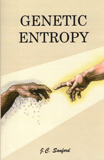Gene Duplication
Evolution Shooting Itself in the Foot
Abstract
Gene duplications followed by subsequent mutation of the duplicated genes are often cited by evolutionists as a mechanism for adding new information to the genome.
Keywords: gene duplication, evolution, mutations, DNA, molecules-to-man, genetics, Sean Carroll, Saccharomyces cerevisiae, baker's yeast, Kluyveromyces lactis, duplication-degeneration-complementation, DDC model
Gene duplications followed by subsequent mutation of the duplicated genes are often cited by evolutionists as a mechanism for adding new information to the genome and providing new functions to the organism. Over millions of years this is thought to lead from molecules to man. Sean Carroll, author of a recent article in Nature on gene duplication in yeast,1 states, “This is how new capabilities arise and new functions evolve. This is what goes on in butterflies and elephants and humans. It is evolution in action.”2 However, to my “surprise,” Carroll’s research showed exactly the opposite—the complete impotence of gene duplication and mutations as a force driving molecules-to-man evolution.
Investigating 100-million-year-old Events
Carroll and others studied the galactose use pathway in Saccharomyces cerevisiae, commonly known as baker’s yeast. This pathway enables yeast to metabolize the sugar galactose. S. cerevisiae is thought to have evolved from the yeast Kluyveromyces lactis 100 million years ago.1 Supposedly, the whole genome of K. lactis was duplicated—some of the duplicated genes were lost, and some were kept. This resulted in the formation of S. cerevisiae.
The focus of the research was two specific genes found in S. cerevisiae, GAL1 and GAL3, which code for proteins that function in the galactose use pathway. In the “ancestral” K. lactis one gene (called GAL1) serves the function of both GAL1 and GAL3. Carroll’s team believes that this is evidence of the past duplication event which led to S. cerevisiae.1
It is important to note that the two genes in S. cerevisiae do not perform any new or different function than the one gene in K. lactis. This has been observed in other studies of supposed gene duplications—rather than resulting in “neofunctionalization” (new functions) the result is “subfunctionalization” (dividing of the functions among two or more genes).1 A model that has been developed to account for this is called duplication-degeneration-complementation (DDC) and “. . . explains the preservation of duplicate genes by a neutral mechanism in which each paralogue [duplicated gene] accumulates loss-of-function mutations (degeneration) that are complemented by the other copy.”1
Let us look at an analogy to better understand this. Suppose I have a TV, and one day it loses the ability to produce sound, although it still has the ability to produce pictures. I go to a used TV shop and find the exact same make and model of TV as the one I have at home, though this one produces sound but not pictures. I purchase the broken TV, take it home, and put it beside my broken TV. The two broken TVs complement each other (they have different defects), and together make it possible for me to see the picture and hear the sound for any given TV program. However, my broken TVs are not doing anything new. So, obviously the DDC model is not sufficient alone for evolution to occur, since no new functions are being gained and this is a requirement for molecules-to-man evolution. Rather, DDC is seen as a first step to preserve the duplicated genes, as non-functional genes would not be selected for and are lost via genetic drift (just as most people would probably throw away the broken TVs).
The next step in this model is additional mutations that modify the genes so that they perform their current function “optimally” and eventually perform completely new functions (although the latter was not observed in the yeast study). DDC is thought to relieve an “adaptive conflict”.1 Genes (and their proteins) typically perform multiple functions (i.e. they may serve in multiple metabolic pathways, etc.). Thus, many mutations that might optimize one function of the gene would harm another function of the gene (the adaptive conflict), and so, the majority of mutations would be detrimental and selected against.
The situation resembles a stalemate in which the genes essentially do not change. Duplication resolves this conflict by allowing each duplicated gene to perform a singular function. The overall function of the genes in a given pathway is preserved, and now mutations in the genes can be selected for that will optimize that specific function. This supposedly happened in S. cerevisiae with the GAL1 and GAL3 genes (duplicate of the GAL1 gene in K. lactis), and this led to “. . . more complex and, in some ways, [a] more optimal genetic pathway.”1
Were You There?
Once again we have a classic case of circular reasoning. The scientists must assume evolution is true to claim that duplication events 100 million years ago led to the species S. cerevisiae, but then claim that these duplication events are evidence of “evolution in action.” It cannot be evidence for something if you must assume that something is already true to interpret the evidence!
The DDC Model and Creation
The DDC model by itself may potentially fit within a creation framework. The model encompasses mutations in genes that lead to loss of information and/or function. These mutations could potentially compensate for each other if this were occurring in two copies of the same gene. This would resemble a case where individuals are carriers for certain recessive genetic disorders: they have two copies for every gene (one from mom and one from dad); one copy is defective (mutations), and one is normal (no mutations). The normal gene compensates for the defective gene, and thus, the individual does not have the disease. Duplication of genes followed by compensatory mutations may be a mechanism for survival of organisms in a post-Fall world.
The problem comes with the next step, which involves mutations that supposedly lead to “optimization” of the singular functions of the genes (and eventually to new functions of the genes). Natural selection does not occur at the DNA (genotypic) level—only at the whole organism (phenotypic) level.3 The mutations in the duplicated genes would need to lead to proteins that significantly alter the fitness or survival of the whole organism. The article indicated that the fitness differences in the yeast studied were very small, requiring an extremely sensitive assay.1 Thus, it is likely that these “optimization” mutations would not accumulate and be lost by genetic drift.
Not “Evolution in Action”
What is clearly not shown in the article is evidence for molecules-to-man evolution. Instead, we observe just how powerless duplication and mutation really are for adding new information that leads to the gain of new functions. However, the authors of the article seem to think otherwise. Carroll states, “They [GAL1 and GAL3 in S. cerevisiae] became optimally connected in that job [their role in the galactose use pathway]. They’re working in cahoots, but together they are better at the job the ancestral gene held. Natural selection has taken one gene with two functions and sculpted an assembly line with two specialized genes.”2 The Nature article also states, “After whole-genome duplication, S. cerevisiae GAL1 and GAL3 were integrated into a more complex and, in some ways, more optimal genetic pathway.”1
These statements are a clear example of prejudicial conjecture on the part of the scientists and not based on fact. The terms optimal, better, and more complex are based solely on their conjecture or assumption that the more “advanced” S. cerevisiae evolved from the more “primitive” yeast K. lactis 100 million years ago. The preferred evolutionary scenario would seem to be just the opposite: S. cerevisiae would be the ancestor, since it requires two genes for the same job that K. lactis manages to do with just one gene.
Carroll states, “We retraced the steps of evolution.”2 “Retraced”? What they did was concoct an evolutionary scenario with which to interpret the data in order to get an evolutionary conclusion! Evolution infers a gain of new information and new functions. All of the mutations they think have occurred in the GAL1 and GAL3 genes in S. cerevisiae are loss of information and/or function mutations when compared to the GAL1 gene in K. lactis. They involve the loss of binding sites for proteins, the loss of enzymatic activity, and the loss of orientation of the binding sites. So, no new information, no new functions, and yeast are still yeast!
Carroll also states, “When compounded over time, these very small changes [that have led to the formation of GAL1 and GAL3 in S. cerevisiae] make one group of organisms successful and they out-compete others.”2 Within a creationist framework it is possible that K. lactis and S. cerevisiae are members of the same kind of yeast and that alterations (including duplications and mutations) occurred in the past leading to the formation of S. cerevisiae from K. lactis or vice versa. Both K. lactis and S. cerevisiae exist today; so, it may be that certain environmental conditions have led to their formation from each other.
The evidence seems to fit the creationist orchard model of variation within a kind while not supporting the evolutionary tree of life model of evolution from one kind to another. It is also possible that S. cerevisiae and K. lactis are representatives of different created kinds of yeast and that the genetic differences in GAL1 and GAL3 are merely part of the original created genetic diversity. Once again we are presented with evidence of God’s amazing design and provision in a post-Fall world for even some of the smallest members of His creation.
Footnotes
- Chris Todd Hittinger and Sean B. Carroll, “Gene Duplication and the Adaptive Evolution of a Classic Genetic Switch,” Nature 449 (2007): 677–682.
- ScienceDaily, “A Gene Divided Reveals the Details of Natural Selection,” October 15, 2007.
- John Sanford, Genetic Entropy and the Mystery of the Genome (Lima, New York: Elim Publishing, 2005).
Recommended Resources

Answers in Genesis is an apologetics ministry, dedicated to helping Christians defend their faith and proclaim the good news of Jesus Christ.
- Customer Service 800.778.3390
- © 2024 Answers in Genesis




